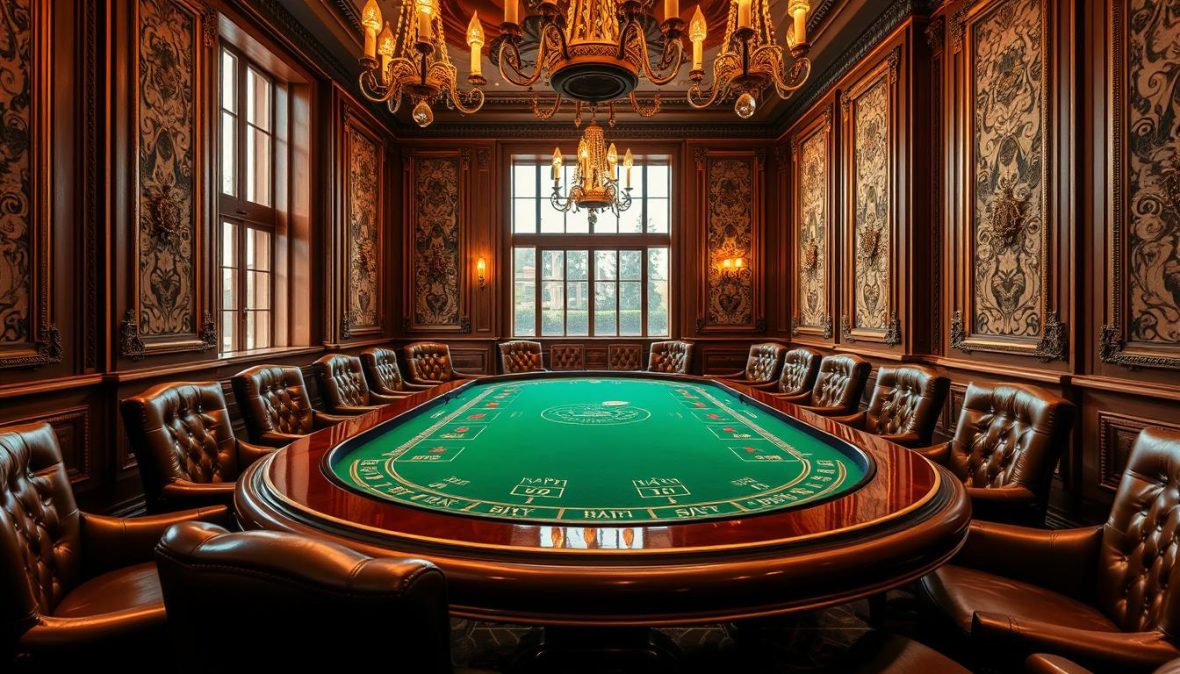Unlock the Secrets of Baccarat: Learn to Play Today

Surprising fact: Mini Baccarat uses eight decks and a single shoe, yet a natural 8 or 9 ends a hand instantly — that small rule changes outcomes far more than most players realize.
I wrote this as a practical, first-person guide that shows how to play baccarat without the fluff. The object is simple: reach a score nearest nine. Face cards and tens count zero; aces are one.
Two cards go to the Player side and two to the Banker. If either side has an 8 or 9, the hand stops. Bets fall on Player, Banker, or Tie before the dealer closes action.
I mix live-room habits with solid evidence: casino-backed rules, a trainer that mirrors real dealing styles, and a stats board that tracks Banker/Player/Tie percentages and composition-based edges late in the shoe. Expect clear notes on payouts, commissions, and a few table tips I use when teaching friends.
Key Takeaways
- Mini Baccarat uses eight decks and a shoe; naturals (8/9) end hands immediately.
- Face cards and tens = 0; aces = 1; the main object is a total closest to nine.
- Bets: Player, Banker (5% commission on wins), or Tie (8:1 payout).
- Practical tools include a trainer and scoreboards that mirror casino tables.
- Late-shoe composition and simple statistics can reveal small edges.
Quick-Start Guide: How to Play Baccarat at the Table
Step into a mini baccarat table and you’ll see a tight, fast rhythm driven by one clear object: get a hand closest to nine. I watch the dealer pull cards from the shoe and call totals aloud. That steady pace makes the game easy to follow.
Card values and the basic deal
Face cards and tens count zero; aces are one. All other ranks equal their pip value. The dealer deals two cards to the Player side and two cards to the Banker side. Totals are announced immediately.
Setup, bets, and flow at the table
Mini baccarat uses eight shuffled decks in a dealer’s box or shoe. Up to seven people may place bets. Before cards move, bets placed go on Player, Banker, or Tie. You never handle the cards; the dealer controls draws under set rules.
| Item | Detail | Typical Value |
|---|---|---|
| Decks in shoe | Shuffled into box | 8 decks |
| Cards dealt | Initial deal | Two cards each |
| Common payouts | Player / Banker / Tie | Even / Even -5% / 8:1 |
| Max players | At a mini table | 7 persons |
Rules, Dealing, and Drawing: From Two Cards to the Third Card
The dealer slides two cards from the shoe into each side — Player and Banker — then reads the point totals aloud.
If either side totals an 8 or 9 that round ends immediately; those naturals stop the hand and no third card appears.
Player and Banker draw rules
The Player side is simple: totals 0–5 draw one card; 6 or 7 stand; 8–9 are naturals. No choices. Just rules the dealer enforces from the box.
The Banker follows a conditional matrix. Banker draws on 0–2 and stands on 7, 8, 9.
With Banker 3, draw unless the Player’s third card is 8. With Banker 4, draw if the Player’s third card is 2–7. With Banker 5, draw if the Player’s third card is 4–7. With Banker 6, draw only if the Player’s third card is 6–7.
Payouts and table terms
Player wins pay even money. Banker wins also pay even money but a 5% commission is charged. Tie bets pay 8:1 when both hands finish with the same point total.
| Item | Detail | Typical value | Note |
|---|---|---|---|
| Initial deal | Two cards per side | From shoe/box | Dealer reads points |
| Natural | Immediate stop | 8 or 9 | No third card |
| Face cards | Value | 0 | King, Queen, Jack, Ten = zero |
| Bets & payouts | Player / Banker / Tie | Even / Even less 5% / 8:1 | House math |
At a mini baccarat table the pace is brisk because the dealer controls cards and draws. The matrix looks fiddly on paper, but at the table it runs like clockwork.
Tools to Learn and Practice Better Play (with Statistics)
I lean on simulation software that matches the dealer’s pace and exposes real card counts.
The interactive trainer lets me pick mini baccarat for quick dealing or big table mode where a player flips a card. A hybrid option reveals only third cards for authentic timing while preserving fixed draw rules.
Scoreboards and what they mean
Bead Plate, Big Road, Small Road, Big Eye Boy, and Cockroach Pig are all available. The trainer explains each chart in plain text so players read patterns without mistaking noise for signal.
Statistics board and composition insights
The stats board summarizes the last shoe and shows Banker, Player, and Tie percentages. It also lists remaining ranks so you watch how a single card shifts the house edge on a given bet.
| Feature | What it shows | Why it matters |
|---|---|---|
| Modes | Mini / Big / Hybrid | Match real table timing |
| Scoreboards | All five common charts | Read other players’ cues |
| Stats | Shoe summary & rank counts | Composition-based house edge |
| Bankroll | $10,000 start, $5 min | Practice money management |
Practice becomes useful when replaying tough hands and watching how point math changes with one card. It’s honest training that turns guessing into tested habits.
Statistics, Graphs, and Predictions for Baccarat Outcomes
Numbers on a trainer’s stats board tell a clearer story than any streak at the table.
I plot three bars—Banker, Player, and Tie—using last-shoe percentages from the trainer. I then annotate each bar with the composition-derived house edge so the graph reflects the cards dealt, not a generic average.
The trainer also lists remaining ranks and a live edge line. That line shows when the math drifts late in the shoe and a third card is slightly more likely to swing a marginal hand.
Quick visual summary
| Outcome | Last shoe % | Example house edge |
|---|---|---|
| Banker | 45% | ~1.06% (after commission) |
| Player | 44% | ~1.24% |
| Tie | 11% | ~14–15% (high) |
My prediction is modest. If the composition panel shows low cards clustering, expect slightly more naturals and a small edge shift. That changes my bets placed and money sizing, not my beliefs about certainties.
Practical rule: watch the edge line late in the shoe. Reduce size or sit out when the composition widens. Treat tie bets as informational and size them conservatively when an unusual skew appears.
Conclusion
Final thoughts: keep your plan small, your bets modest, and your attention on the cards.
Learn the rules, watch the dealer resolve drawing, and treat the third-card moments as the real turning points. The game rewards clarity more than clever systems.
I use a trainer and run ten shoes, then compare composition-based edges. If you want a structured drill, try this trainer guide: trainer routine and notes.
Quick FAQ: Banker usually holds a small edge; tie is a long-odds side bet; drawing is automatic. Plan bet size before the hand, and adjust only when the data — not emotion — says change.
One simple rule: know two cards, respect the matrix, and let the shoe guide your money. That way the game stays fun and measured.
